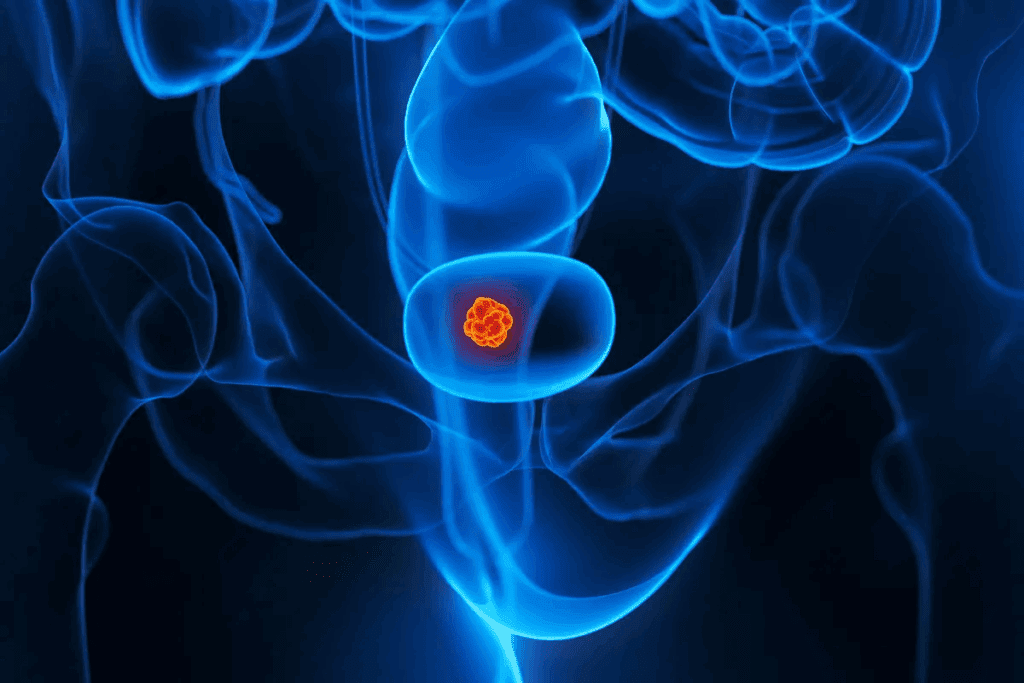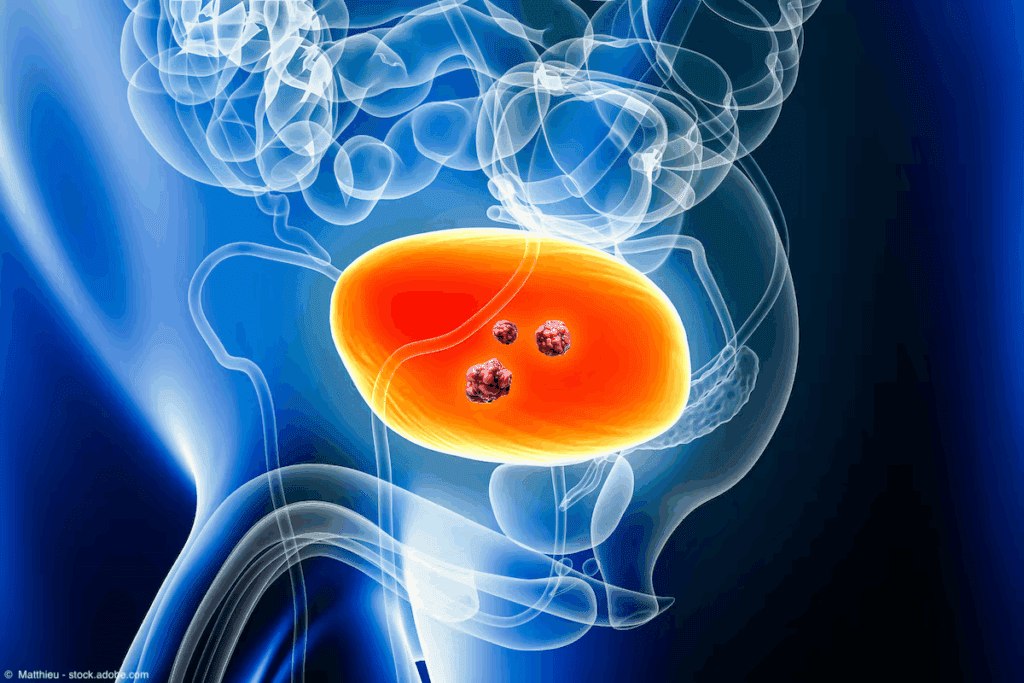Last Updated on November 25, 2025 by Ugurkan Demir

Getting a diagnosis of advanced bladder cancer can feel scary. But knowing what you’re dealing with is the first step to making good choices about your health. We’re here to help you understand Stage 3 bladder cancer. This is when the cancer has grown through the muscle layer into fatty tissue around it. It might also have spread to nearby lymph nodes. Learn about stage 3 bladder cancer symptoms, treatment, prognosis, and survival rates. A complete overview of advanced bladder cancer.
The five-year survival rate for this stage is about 39 percent, based on recent data. Spotting symptoms like blood in the urine early and seeing a doctor quickly can really help. We’ll look at what Stage 3 bladder cancer is, its outlook, and treatment choices to guide you.

Stage 3 bladder cancer is a serious condition. It means the cancer has grown through the bladder’s muscle layer and into the fat layer around it. It might also have spread to nearby organs or lymph nodes, making it more advanced.
Stage 3 bladder cancer is known as muscle-invasive bladder cancer. This means it has gone through the bladder’s muscle wall. It’s a more serious type of cancer that needs stronger treatments.
Stage 3 bladder cancer is different from earlier stages. Stages 1 and 2 are not as deep in the bladder. Stage 3 has grown beyond the bladder, possibly reaching nearby organs or lymph nodes. This makes it stand out from other stages.
Knowing the difference between stage 3 and other stages is key. It helps doctors choose the right treatment and understand what to expect. We’ll look into this more in the next sections.

Knowing the symptoms of stage 3 bladder cancer is key for early treatment. We’ll look at both early signs and advanced symptoms as the cancer grows.
Hematuria, or blood in the urine, is a common early sign. It makes urine look pink, red, or dark brown. This symptom is often painless, making it hard to notice.
Other early signs include:
These symptoms can be like those of less serious issues. It’s important to see a doctor for a correct diagnosis.
As stage 3 bladder cancer gets worse, more symptoms appear. These can really affect your life. They include:
Telling your healthcare team about new or getting worse symptoms is key. They can change your treatment plan.
Handling these symptoms is tough. Our healthcare team is here to offer full support and care. We aim to manage these symptoms well.
Stage 3 bladder cancer is a serious point where the cancer’s impact grows. It affects many health areas. At this stage, the cancer has grown through the bladder’s muscle layer. It may also spread to nearby tissues or lymph nodes.
Stage 3 bladder cancer often spreads to fatty tissue around it. This tissue, or adipose tissue, helps the cancer spread further. As it invades this tissue, it can cause pain and discomfort in the pelvic area.
Stage 3 bladder cancer affects men and women differently. In men, it can reach the prostate. In women, it may affect the uterus or other nearby structures. Knowing these differences is key for effective treatment plans.
Lymph nodes are a big concern in stage 3 bladder cancer. When cancer cells get to the lymph nodes, it means the disease is more advanced. Lymph nodes filter out harmful substances, including cancer cells.
If cancer reaches the lymph nodes, treatment plans may change. Checking for lymph node involvement is important. It helps accurately stage the cancer and plan the right treatment.
To find out if someone has Stage 3 bladder cancer, doctors use many tests. These tests help figure out how far the cancer has spread. They also help decide the best treatment.
There are several tests to find bladder cancer. Cystoscopy uses a thin tube with a camera to see inside the bladder. The Transurethral Resection of Bladder Tumor (TURBT) removes a tumor or a sample for checking.
CT scans, MRI, and ultrasound are used too. They help see if the cancer has spread to nearby tissues or lymph nodes. This info is key for planning treatment.
Doctors use tests to see if the cancer is Stage 3. They check if the cancer has gone into the bladder’s muscle layer. They also look if it has spread to fatty tissue or lymph nodes.
The stage of cancer is very important. It helps decide how to treat Stage 3 bladder cancer. Treatments might include surgery, chemotherapy, or radiation therapy.
| Diagnostic Test | Purpose |
| Cystoscopy | Visual examination of the bladder interior |
| TURBT | Removal of tumor for biopsy |
| CT Scan | Assess cancer spread to surrounding tissues and lymph nodes |
| MRI | Detailed imaging of soft tissues |
| Ultrasound | Evaluation of bladder and surrounding structures |
Getting the cancer stage right is very important. It helps know what to expect and how to treat it. We help patients understand their diagnosis and treatment plan.
Patients with Stage 3 bladder cancer have several treatment options. These choices depend on their health and what they prefer. Usually, a mix of treatments is used to get the best results.
Surgery is a key treatment for Stage 3 bladder cancer. The main surgery is a radical cystectomy. This means removing the bladder, nearby lymph nodes, and sometimes other organs.
For men, this might include taking out the prostate and seminal vesicles. Women might have their uterus, ovaries, and part of the vagina removed.
After surgery, there are different ways to handle urine. These include:
Chemotherapy is often used with surgery or radiation. Neoadjuvant chemotherapy is given before surgery to shrink the tumor. Adjuvant chemotherapy is after surgery to kill any remaining cancer cells.
The success of chemotherapy varies. But studies show it can improve survival rates for muscle-invasive bladder cancer.
| Chemotherapy Protocol | Success Rate |
| Neoadjuvant Chemotherapy | Improved survival rates by up to 15% |
| Adjuvant Chemotherapy | Reduces risk of recurrence by up to 20% |
Radiation therapy is another option for Stage 3 bladder cancer. It’s often used with chemotherapy. External beam radiation therapy (EBRT) uses beams from outside the body to target cancer cells.
Combining chemotherapy and radiation can be effective. It might help keep the bladder. The choice depends on the patient’s health, cancer stage, and personal preferences.
Stage 3 bladder cancer survival rates give us insights into what to expect. They are key for patients and their families facing cancer treatment.
The five-year survival rate for stage 3 bladder cancer is about 39.5 percent. This means patients with stage 3 cancer have a 39.5% chance of living at least five years after diagnosis. Survival rates depend on many things, like the cancer’s stage, overall health, and how well treatment works.
Getting a stage 3 bladder cancer diagnosis can feel scary. But knowing the survival rates helps in talking about treatment plans with doctors.
Many things can change how long someone with stage 3 bladder cancer might live. These include:
Doctors can give more tailored advice and support by thinking about these factors. This helps patients on their treatment path.
In summary, while the five-year survival rate for stage 3 bladder cancer is important, it’s just one part of understanding the disease. We suggest patients talk to their healthcare team about their specific situation and treatment options. This way, they can get a better idea of what to expect.
The outlook for stage 3 bladder cancer depends on several things. These include the cancer’s details and the patient’s health. Knowing these factors helps patients understand their life expectancy and treatment results.
Several key factors affect the prognosis for stage 3 bladder cancer. These include:
Lymph node involvement is a critical factor, as it signifies that the cancer is progressing beyond the initial site. The number and location of affected lymph nodes can significantly influence the prognosis.
Patients with stage 3 bladder cancer have a chance of achieving remission and long-term survival. The likelihood of remission depends on factors like tumor characteristics and lymph node involvement.
With the right treatment, some patients can achieve complete remission. This means there’s no cancer evidence after treatment. The five-year relative survival rate for stage 3 bladder cancer gives insight into the long-term outlook. Yet, individual results can vary a lot.
We stress that each patient’s journey is unique. While statistics offer a general view, they don’t predict individual outcomes. Factors like treatment response and overall health greatly influence long-term survival.
Living with stage 3 bladder cancer needs a full plan. This includes handling treatment side effects and getting emotional support. We know this diagnosis is tough, but with the right help, patients can get through it.
It’s key to manage side effects well to keep quality of life. Side effects like fatigue, urinary issues, and bowel changes are common. Patients should work with their healthcare team to find ways to lessen these effects.
Strategies for managing side effects might include changing diets, taking meds, or trying acupuncture or meditation. Keeping a symptom journal helps track side effects and talk to doctors about them.
Follow-up care is vital for stage 3 bladder cancer patients. Regular visits help catch any signs of the cancer coming back early. Patients should stick to their follow-up schedule and tell their doctors about any new symptoms.
How often to visit the doctor depends on the treatment and health. Follow-up care often includes tests, blood work, and physical checks. Being active and alert about follow-up care is important for long-term success.
Emotional and psychological support is key for stage 3 bladder cancer patients. The emotional impact of the disease can be as tough as the physical. Support groups, counseling, and online resources can offer comfort and advice.
Patients should look into different support options to find what suits them best. Whether it’s talking to others who’ve gone through similar things or getting professional help, there are many resources to help with the emotional side of living with stage 3 bladder cancer.
Understanding stage 3 bladder cancer is key for patients to handle their diagnosis and treatment well. We’ve looked at the signs, diagnosis, and treatment options for this condition. It’s important to have a full care plan and support.
The survival rate for bladder cancer changes based on treatment success. Knowing this helps patients set realistic goals and make smart care choices.
Dealing with stage 3 bladder cancer needs a mix of treatments like surgery, chemo, and radiation. A treatment plan made just for you can help improve your chances of survival and quality of life.
In conclusion, managing stage 3 bladder cancer needs a whole approach. This includes medical care, emotional support, and ongoing check-ups. With the help of healthcare experts, patients can face this tough time with hope and confidence.
Stage 3 bladder cancer is a serious form of bladder cancer. It grows into the muscle layer of the bladder. It might also spread to nearby organs or lymph nodes.
Symptoms include blood in the urine, needing to urinate often, and pain while urinating. You might also feel pain in your abdomen.
Doctors use tests like cystoscopy and CT scans to find the cancer. A biopsy confirms the cancer’s stage and how far it has spread.
Treatments include surgery, chemotherapy, and radiation. The best option depends on the cancer and your health.
The five-year survival rate is about 40-50%. This is for cases where the cancer has spread to nearby areas.
While “cure” is complex, some people can go into remission. This can greatly improve their life expectancy.
Your prognosis depends on how far the cancer has spread. It also depends on your health, how well you respond to treatment, and if it has invaded nearby areas.
It can greatly affect your life, causing problems with urination and emotional health. It also impacts your physical health.
There are many resources like support groups and counseling. Healthcare teams also specialize in bladder cancer care.
Life expectancy varies. It depends on how well treatment works, your health, and any other health conditions you have.
Success rates vary. They depend on how well the cancer responds to treatment, your health, and if you’re getting chemotherapy alone or with other treatments.
Advanced symptoms include severe pain and significant weight loss. Signs of cancer spreading to other parts of the body also indicate a worse disease progression.
Subscribe to our e-newsletter to stay informed about the latest innovations in the world of health and exclusive offers!